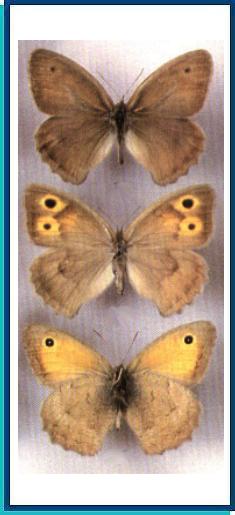LEPIDOPTERA
S A T Y R I D A E Boisduval, 1833
HYPONEPHELE Mushamp, 1915
Hyponephele lycaon (Rottemburg, 1775)
Hyponephele lycaon (Rottemburg, 1775)

· TYPE LOCALITY. "Deutschland, Brandenburg" [Berlin, Germany].
· RANGE. Europe, the Caucasus and Transcaucasia, temperate Asia from Turkey to Mongolia, China and S. Siberia; ?Kopet-Dagh.
· DISTRIBUTION AND VARIATION. The nominate subspecies is distributed in the European part (except for the northern areas), Ciscaucasia, the Urals and N. Kazakhstan. The N. Caucasus (the Teberda and Mt. Elbrus areas) is populated by the ssp. alpherakyi Sheljuzhko, 1937. The Altai, the south of W. Siberia, the Baikal area and W. Transbaikalia harbour the ssp. catamelas (Staudinger, 1886), though it shows no real differences from European specimens and most probably should be regarded as a synonym of the nominate subspecies. In S. Tuva, the ssp. catalampra (Staudinger, 1895) is known to occur. The presence of the species in Kopet-Dagh requires confirmation. Populations from S. Transcaucasia and the Talysh Mts., as well as from the adjacent areas of NW. Iran (the W. and E. Azerbaijan provinces) deserve the status of a separate taxon - ssp. zuvandica Samodurov et Koroljev, 1996 (bona sp.?).
· HABITAT AND BIOLOGY. All over its range, H. lycaon is commonly found in grassy and flowery as well as arboreal habitats on plains and at foothills, in the mountains reaching 1,500-1,800 m, up to 2,500 m a.s.l. in the Caucasus and Transcaucasia. Flight period: June-September depending on the altitude and climatic conditions. Larvae hibernating. Host plants (Lang, 1884; Hesselbarth et al., 1995; etc.): grasses, mostly Poa spp.
· SIMILAR SPECIES. H. lupina: male androconial area on FW broad and downy; female UPF pale bordering of eye-spots separate. H. interposita: wing pattern and colour different; male androconial area broad; female FW with a single eye-spot; UNH in both sexes with a subapical spot. H. lycaonoides: larger; wings broad and rounded; male wings with a more or less conspicuous ochreous area; androconial area broad; HW outer edge more strongly undulate; UNH paler (especially in females) with conspicuous markings. H. dzhungarica: male apical eye-spot on FW large, sometimes accompanied by another spot in cell Cu1-Cu2; UPF eye-spots diffusely bordered by ochreous colour; UNH paler with a more or less strongly developed band; ochreous-yellow area in females well-developed (also on HW). H. pasimelas: larger; UNF darkened in both sexes, ochreous colour up to totally absent; female UPF eye-spots with a very poorly developed pale yellow border.
Photo and text: Guide to the BUTTERFLIES OF RUSSIA and adjacent territories Volume 1. PENSOFT, Sofia - Moscow. 1997